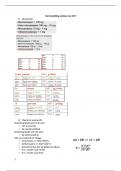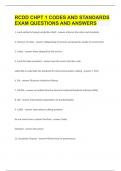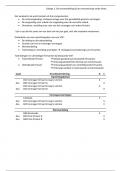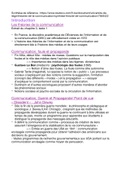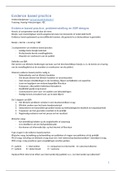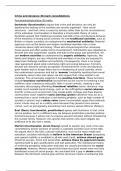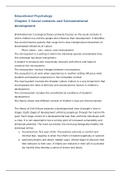Cell Division
Cell Cycle: highly ordered sequence of events that takes place in a cell, resulting in cell
division + formation of 2 genetically identical daughter cells
2 main phases:
Interphase:
● Period of cell growth and DNA replication
● Resting phase as cells are not actively dividing, however cells are very active - carry
out all of its major functions (producing enzymes/hormones)
During Interphase:
● DNA is replicated + checked for any errors
● Protein synthesis occurs in cytoplasm
● Mitochondria grow and divide, increasing in number in cytoplasm
● Chloroplasts grow + divide in plant + algal cell cytoplasm, increasing in number
● Normal metabolic processes of cells occur
3 stages:
● G1 - 1st growth phase: proteins from which
organelles are synthesised are produced +
organelles replicate - cell increase in size
● S - Synthesis phase: DNA replicated in
nucleus
● G2 - 2nd growth phase: cell continues to
increase in size - energy stores increased +
duplicated DNA checked for errors
Mitotic phase: period of cell division
2 stages:
Mitosis: nucleus divides
Cytokinesis: cytoplasm divides + 2 cells are produced
G0 phase: name given to phase when cell leaves the cycle
Reasons for this:
● Differentiation: Cell that becomes specialised to carry out a particular function is no
longer able to divide
● DNA of cell may be damaged - no longer viable - no longer divide and enters period
of permanent cell arrest (G0)
● Age - number of old cells increases - age related diseases
, Checkpoints: control mechanisms of cell cycle. Monitor + verify whether the processes at
each phase have been accurately completed
G1 - end of G1 phase. If cell satisfies requirements = triggered to begin DNA replication
otherwise it goes to G0
G2 - End of G2 phase, before start of mitotic phase. If passed, cell initiates molecular
processes that signal beginning of mitosis
Metaphase checkpoint - all chromosomes should be attached to spindles + have aligned
Stages of Mitosis:
Mitosis needed for growth, repairing + replacing damaged tissues, + asexual reproduction
Prophase:
● Chromosomes condense - shorter + fatter. Tiny bundles of protein (centrioles) start
moving to opposite ends of cell, forming the spindle (network of protein fibres)
● Nuclear envelope breaks down + chromosomes lie free in cytoplasm
Metaphase:
● Chromosomes (each with 2 chromatids [strands])line up at centre of cell + attached
to spindle by centromere
● Metaphase checkpoint checks if chromosomes are attached to spindle
Anaphase:
● Centromeres divide, separating each pair of sister chromatids. Spindles contract,
pulling chromatids to opposite ends of cell, centromere first
Telophase:
● Chromatids reach opposite poles of spindle. Uncoil + become long/thin =
chromosomes
● Nuclear envelope forms around each group of chromosomes so 2 nuclei
Meiosis - type of cell division that happens in reproductive organs to produce gametes
Produces haploid cells (cells with ½ number of chromosomes) from diploid cells
2 divisions: Meiosis I (reduction division - 1/2s chromosome number) and Meiosis II
Meiosis I:
Prophase:
● Chromosomes condense - getting shorter + fatter. Then arrange themselves into
homologous pairs (same size + genes) + crossing over occurs
● Centrioles move to opposite ends of cell, forming spindle fibres. Nuclear envelope
breaks down
Metaphase: Homologous pairs line up across centre of cell + attach to spindle fibres by
centromeres
Anaphase: Spindles contract, separating homologous pairs - 1 chromosome goes to each
end
Telophase: Nuclear envelope forms around each group of chromosomes
Cytokinesis: division of cytoplasm occurs + 2 haploid daughter cells are produced
Cell Cycle: highly ordered sequence of events that takes place in a cell, resulting in cell
division + formation of 2 genetically identical daughter cells
2 main phases:
Interphase:
● Period of cell growth and DNA replication
● Resting phase as cells are not actively dividing, however cells are very active - carry
out all of its major functions (producing enzymes/hormones)
During Interphase:
● DNA is replicated + checked for any errors
● Protein synthesis occurs in cytoplasm
● Mitochondria grow and divide, increasing in number in cytoplasm
● Chloroplasts grow + divide in plant + algal cell cytoplasm, increasing in number
● Normal metabolic processes of cells occur
3 stages:
● G1 - 1st growth phase: proteins from which
organelles are synthesised are produced +
organelles replicate - cell increase in size
● S - Synthesis phase: DNA replicated in
nucleus
● G2 - 2nd growth phase: cell continues to
increase in size - energy stores increased +
duplicated DNA checked for errors
Mitotic phase: period of cell division
2 stages:
Mitosis: nucleus divides
Cytokinesis: cytoplasm divides + 2 cells are produced
G0 phase: name given to phase when cell leaves the cycle
Reasons for this:
● Differentiation: Cell that becomes specialised to carry out a particular function is no
longer able to divide
● DNA of cell may be damaged - no longer viable - no longer divide and enters period
of permanent cell arrest (G0)
● Age - number of old cells increases - age related diseases
, Checkpoints: control mechanisms of cell cycle. Monitor + verify whether the processes at
each phase have been accurately completed
G1 - end of G1 phase. If cell satisfies requirements = triggered to begin DNA replication
otherwise it goes to G0
G2 - End of G2 phase, before start of mitotic phase. If passed, cell initiates molecular
processes that signal beginning of mitosis
Metaphase checkpoint - all chromosomes should be attached to spindles + have aligned
Stages of Mitosis:
Mitosis needed for growth, repairing + replacing damaged tissues, + asexual reproduction
Prophase:
● Chromosomes condense - shorter + fatter. Tiny bundles of protein (centrioles) start
moving to opposite ends of cell, forming the spindle (network of protein fibres)
● Nuclear envelope breaks down + chromosomes lie free in cytoplasm
Metaphase:
● Chromosomes (each with 2 chromatids [strands])line up at centre of cell + attached
to spindle by centromere
● Metaphase checkpoint checks if chromosomes are attached to spindle
Anaphase:
● Centromeres divide, separating each pair of sister chromatids. Spindles contract,
pulling chromatids to opposite ends of cell, centromere first
Telophase:
● Chromatids reach opposite poles of spindle. Uncoil + become long/thin =
chromosomes
● Nuclear envelope forms around each group of chromosomes so 2 nuclei
Meiosis - type of cell division that happens in reproductive organs to produce gametes
Produces haploid cells (cells with ½ number of chromosomes) from diploid cells
2 divisions: Meiosis I (reduction division - 1/2s chromosome number) and Meiosis II
Meiosis I:
Prophase:
● Chromosomes condense - getting shorter + fatter. Then arrange themselves into
homologous pairs (same size + genes) + crossing over occurs
● Centrioles move to opposite ends of cell, forming spindle fibres. Nuclear envelope
breaks down
Metaphase: Homologous pairs line up across centre of cell + attach to spindle fibres by
centromeres
Anaphase: Spindles contract, separating homologous pairs - 1 chromosome goes to each
end
Telophase: Nuclear envelope forms around each group of chromosomes
Cytokinesis: division of cytoplasm occurs + 2 haploid daughter cells are produced

